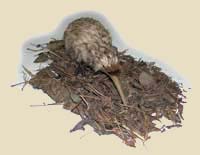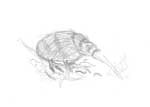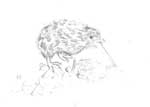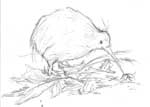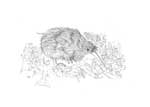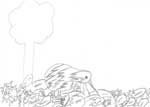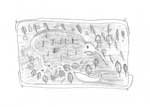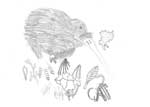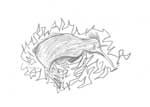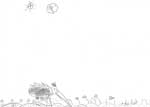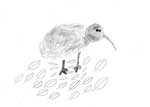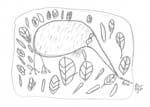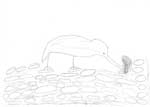| Approach: Independent |
Level: Year 4
and year 8 |
|
| Focus: Students can use drawing processes to describe the main features and form of a displayed object |
| Resources: Kiwi; 4 4B pencils; 4 B4 cartridge paper; bag of leaves; 4 tote trays;
cardboard bases; 4 3-point position bases; (no erasers)
|
| Time: 15 mins |
|
|
|
| Questions/instructions: |
|
On each student’s desk place one 4B pencil, one kiwi (positioned on a 3-point base), and one piece of B4 cartridge paper.
Note: Place the model in the centre of the student’s table, behind the drawing board. Note that the kiwi is to remain in its assigned position throughout the drawing activity.
In this activity you are going to make a drawing of the kiwi standing on the leaves, just as you see it in front of you.
Before you start you might like to have a closer look at the kiwi. You can do that now, but please handle it carefully.?
|
|
Allow students to pick up and examine the model. Then ensure that the model is placed back in the correct position.
For this activity, it is important that you don’t touch the kiwi or change its position while you are making your drawing.
Make sure it is left in the same position all of the time.
Try to make your drawing of the kiwi and what it is standing on as real as you can - just as you see it. And remember what it feels like.
It’s a good idea to start with very light lines, then to make them clearer when you are satisfied with the way you have drawn them.
You don’t need to use a rubber. Just change your lines if you want to make changes.
You have 15 minutes to make your drawing. I want you to use all of that time on your drawing so that it’s as good as you can make it.
Don’t worry if you don’t actually finish your drawing in the 15 minutes. Just do your very best work. You can start now.
After 10 minutes:
You have had 10 minutes so far. You have five minutes left for drawing the kiwi standing on the leaves. |
|
| |
%
responses
2007 ('03) |
y4 |
y8 |
Main features recorded:
[Main body parts/features observed and recorded
(e.g. beak, eyes, feet, body shape); different parts
appropriately shaped and in reasonable proportions.] |
highly developed |
1 (3) |
10 (14) |
moderately developed |
24 (21) |
41 (49) |
slightly developed |
55 (70) |
44 (34) |
under developed |
21 (7) |
5 (3) |
Dimensional quality/3D aspect:
[Shading/perspective (e.g. as indicated
by
treatment of the leaves).] |
highly developed |
2 (4) |
11 (13) |
moderately developed |
12 (9) |
31 (32) |
slightly developed |
38 (41) |
45 (37) |
under developed |
49 (47) |
13 (18) |
Detail:
[Fine detail of features observed and
included (e.g. feet, bark, feathers, eyes);
appropriate tonal marking, textures,
patterns and lines.] |
highly developed |
1 (0) |
9 (12) |
moderately developed |
15 (20) |
37 (38) |
slightly developed |
61 (53) |
49 (43) |
under developed |
24 (27) |
5 (7) |
Expressiveness:
[Lifelike quality; confident treatment; enriched
through subtle individual interpretation.] |
highly developed |
2 (4) |
11 (15) |
moderately developed |
20 (11) |
35 (37) |
slightly developed |
54 (50) |
47 (35) |
under developed |
25 (34) |
8 (13) |
| Global rating: |
excellent |
0 (0) |
2 (1) |
very good |
2 (1) |
8 (8) |
good |
9 (10) |
25 (30) |
fair |
31 (29) |
32 (35) |
poor |
38 (32) |
30 (17) |
very poor |
21 (29) |
3 (9) |
|
Total
score: |
14–17 |
1 (1) |
10 (10) |
11–13 |
5 (6) |
19 (26) |
8–10 |
16 (12) |
23 (20) |
5–7 |
29 (34) |
34 (27) |
0–4 |
48 (47) |
15 (18) |
Students found the task of drawing a kiwi from a model fairly challenging. Although there were some very good to excellent renderings of the kiwi at both year 4 and year 8, there were far more drawings rated in the very poor to poor categories, particularly at year 4. Students had difficulty in making the kiwi look three dimensional, and often ignored finer details in their work. There was growth seen from year 4 to year 8, but only 10% of year 8 students received a global rating of very good (8%) or excellent (2%). Drawings from girls received overall higher ratings than boys at year 4, and Pakeha students outperformed Mäori students at year 4. No other differences approached statistical significance. Performance in 2007 was overall quite similar to 2003.
|
KIWI PENCIL DRAWING EXEMPLARS [click
on pictures to enlarge] –
[Note
that some images have been digitally enhanced to ensure clarity of image
and therefore meaningful reproduction]
|
 |
| High Range: |
|
|
|
|
Year 4 |
Year 8 |
Year 8 |
Year 8 |
The task calls for careful observation skills and the ability to use pencil to suggest form and texture. In this sample, students are achieving contrasting mark making for feathers, beak, legs, bark and leaves. Attention has been given to the orientation of the kiwi, the way its weight is distributed on its sturdy legs and the balance of its overall proportions. The kiwi securely stands in a contrasting forest floor that makes sense spatially.
|
 |
| Mid Range: |
|
|
|
|
Year 4 |
Year 4 |
Year 8 |
Year 8 |
The visual links to the task are clear. However, in the mid-range sample often some aspects in each drawing are well observed while others remain undeveloped or uninformed by observation. Feathers and other surfaces may be given approximations and symbolic mark making to suggest texture. Individual leaves may be given careful but standardised shapes or summarised in random marks. This results in spatial ambiguity, some awkwardness of shape and a lack of overall coherence in the drawing.
|
 |
| Low Range: |
|
|
|
|
Year 4 |
Year 4 |
Year 8 |
Year 8 |
While a kiwi bird in some kind of leafy enclosure may be indicated, students within this range were consistent in producing a personal symbol using a visual summary rather than careful observation. One might expect at year 4 the transition between personal symbol and observation still to be taking place. It would appear that by year 8, at least for some students, their cumulative drawing experiences have lacked the opportunity, challenge and support for further development.
|
|
